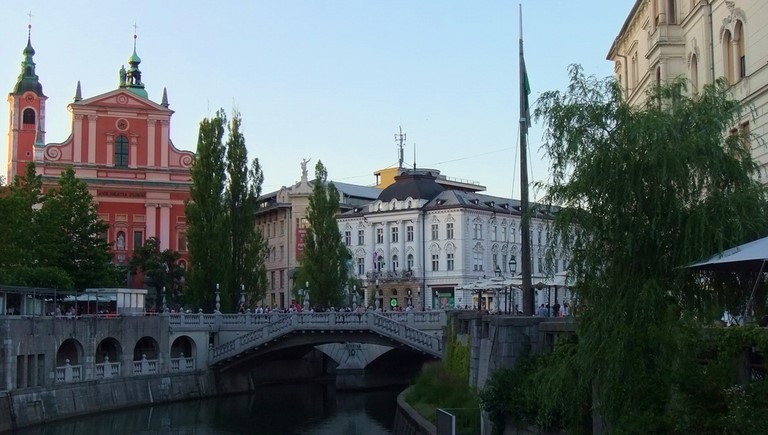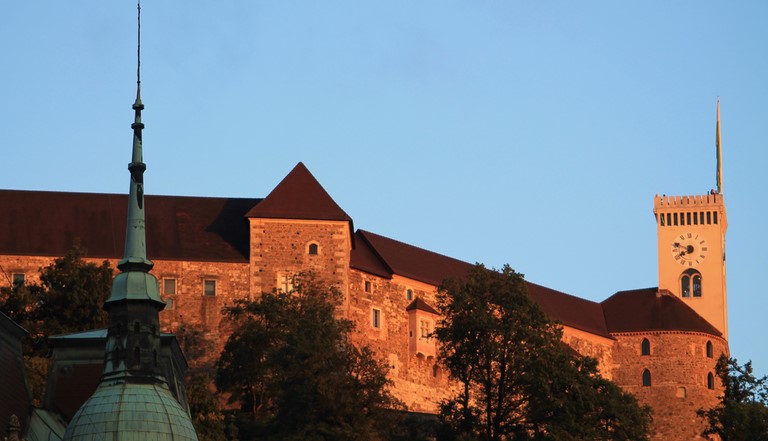Ljubljana, «the beloved»
You can click on pictures to enlarge them
We did not feel love at first sight for Ljubljana. We needed time to catch its inner beauty to adopt it for life. Indeed, «the beloved» has nothing flashy, which makes its charm and its singularity. It is sweet, discreet and likely, which makes its particular fits of fervor all the more pleasant. Like its inhabitants, it is full of simplicity and sincerity. There you meet light and true smiles, an atmosphere bathed in happiness and romanticism, such a gentle way of life that you feel overcome by an indescribable feeling of well-being.
Human-sized capital, you discover and rediscover it walking or biking. And once you let it seduce you, you are so bound to it that you feel the need to come back there regularly.
Tromostjov - Ajdovščina -Tabor - Nove Jarše
The Triple Bridge, both original and attractive artwork, was built by local architect Jože Plečnik. Its stairs to the banks and its columns endow it with a Venetian style. Its line with the Franciscan Church of the Annunciation and its coral-colored façade is the idealized image of the city. Between the two, the all round shaped Prešeren Square is often the locals’ meeting place, and the visitors’ landmark. There take place most of the shows. As you make your way to Čopova Street, you will see a superb scale model of the town made of bronze, as useful as aesthetic because it will eventually help you to find your way around.
Miklošičeva Avenue on its own is worth the visit: there, the Secession style – derived from Art Nouveau – is much in evidence. The fineness of embellishments and the diversity in colors are outstanding. The Galerija Emporium shopping center (former Centromerkur), the Grand Hotel Union and the Zadružna Cooperative Bank with its colored mosaics are the most significant examples.
Other emblematic artwork in Ljubljana, the Dragons Bridge (photo) allows you to cross the Ljubljanica to join Market Square.
East of the station, Metelkova is an independent social and cultural center housed in a former military barrack of the Yugoslavian Army. It is home to art galleries and underground clubs. Its parties are much appreciated. That alternative area is a kind of microcosm in the city. Murals and diverse street-art works are numerous.
More north, the amazing Žale Cemetery is one of the many artworks from the famous architect Jože Plečnik in the city. It includes no less than fourteen mortuary chapels in various styles that bring the place a touch of exoticism. The entrance is composed of an arch in the middle of two impressive semi-circular colonnades. On the top rise the statues of Christ and Mary.
See:
- Ljubljanica banks
- Triple Bridge
- Prešeren Square
- Franciscan Church of the Annunciation
- Miklošičeva Avenue
- Dragons Bridge
- Ethnographic Museum
- Metelkova
- Žale Cemetery
Ljubljanski Grad - Stara Ljubljana - Prule
Combination of different styles and different ages, the set high up Ljubljana Castle (photo) offers a view from above of the town and the surroundings. It is located in both green and shaded area. However, the presence inside of metal protective structures, including cable railings, can be regrettable. The choice of materials going better with stone, such as wood, would have been more appropriate. To join it, two options are available to you: the funicular, or climb on foot for the bravest.
The Saint-Nicholas Cathedral, Baroque gem inherited from the Habsburg, includes Italian influences as well, the whole in a noticeable harmony. You will also find this Transalpine touch very close on the Three Rivers Fountain of Carniola by Francesco Robba.
Stari Trg (Old Square), lively and colored heart of the Old Town, displays superb Rococo style houses. The square is – with the Ljubljanica banks – the locals and tourists’ favorite place to linger or to chat having a drink or a meal on a terrace.
Gornji Trg (Upper Square) displays its colored medieval façades. It is punctuated with narrow passageways filled with charm. Some architectural details in Baroque style complete the picture.
See:
- Ljubjanica banks
- Central Market Square with its columns and its porticoes
- Saint-Nicholas Cathedral
- Three Rivers Fountain of Carniola
- Stari Trg
- Gornji Trg
- Ljubljana Castle
Tivoli – Mirje – Krakovo – Trnovo
Tivoli Park is a 5 hectare park in the heart of the city. It includes a castle and its modern art gallery, sculptures, sports facilities and children games. A Neo-Classical house contains the International Graphic Art Center.
As you make your way to the Ljubljanica banks, you will see numerous religious or cultural edifices, houses with an opulent and old-fashioned charm, the whole in diversity in styles and colors. Kongresni Trg is a significant example: that wide square includes among others the Slovenian Philarmonic. The nearby University provides the area a young and dynamic atmosphere. On the other side rise the colossal outlines of the Church of the Ursulines of the Holy Trinity (photo) that proudly displays its embedded columns. In Baroque style, it was built in 1726. Its altar is the work of Francesco Robba.
Križanke (Cross Monastery) is the former Monastery of the Teutonic Knights. Built in the 13th century and renovated in the 16th century, it was converted into a school. In Gothic Revival style, its inner courtyard displays its façades, its columns and its sgraffiti. The Summer Theater is very pleasant. The complex also includes the Church of Virgin Mary of Bon-Secours, which is unfortunately closed to visitors.
As you move southwards from the city center along the Ljubljanica to Trnovo district, you join the Gruber Channel, an affluent of the river. The part of its banks which faces the Botanical Garden of the University is one of the favorite places of local young people and students who like to meet there at night. The atmosphere there is pleasant and relaxed.
Krakovo, the amazing truck farmer area – which supplies some of the daily market products – is highly prized by artists and architects. There you can find Emona City ruins. The architect Jože Plečnik made his contribution adding a small pyramid to it.
See:
- Tivoli Park and International Graphic Art Center
- Serbian Orthodoxe Monastery
- Opera
- Parliament
- Kongresni Trg
- Slovenian Philarmonic
- University
- Church of the Ursulines of the Holy Trinity
- National and University Library
- Križanke (Cross Monastery)
- Krakovo truck farmer area
- Jože Plečnik’s house
- Emona City ruins
- Ljubljanica banks
- Gruber Channel banks
- Botanical Garden of the University
Modified on May 4th 2019







